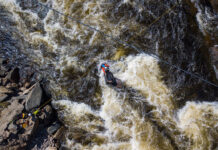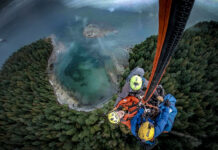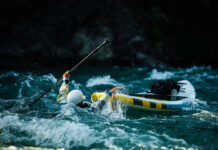Safety first. It’s the golden rule of kayaking. There are hundreds of articles written about the importance of risk management on the river and safety basics are well known and respected by most kayakers. Make yourself so invaluable, everyone will want to paddle with you.
Here are 5 safety kayaking skills to take you to the next level
1 Talk it out
Good communication is so straightforward to play it safe in whitewater it often gets overlooked. This is your key to success on the river. Take just a minute to get your team together and get on the same page at the put-in. If you’re above a big rapid or challenging line, make sure the group has the correct beta.
Set safety for a rapid with high swim potential, establish beforehand who is going to get a swimmer, paddle and kayak, or who is going to throw the first rope. Don’t only do this for gnarly runs, make a habit of communicating on your backyard runs too. The quick conversation to create an action plan for when SHTF will save your ass one day.
2 Overreact every time
Waiting until your fellow paddler is pinned or swimming to react increases the risk of making bad decisions under stress and making a bad situation worse. Be dramatic—make plans for a worst-than-best-case-scenario before it occurs.
My favorite example of overreaction comes from my background teaching children. As soon as a student flips over, I dash towards them, bridging the distance between us. Every single time. Practice the skill even when your friend with a bombproof roll flips over on your warm, deep water backyard run to dial in the habit for those cold, shallow rivers with increased consequences.
Best case scenario, you get a quick sprint and your friend rolls up. If not, you’re there in time to hand of god the kayaker and save a swim. In the worst case, you are much closer to helping with rescue and eliminating unnecessary moments in the water.
3 Hand of God
The ability to roll up a friend, without the kayaker playing a role in his or her own rescue, will earn you endless rounds at the bar aprés paddle and keep your paddling partner dry, warm and in high spirits. The effectiveness of the hand of god in comparison to a T-rescue is like comparing small batch Canadian maple syrup to the maple-flavored high-fructose corn syrup sold on the same shelf. It’s not even in the same league.
A hand of god allows you to come in fast and ensures capsized kayakers go from upside down to right-side-up in moments, without even knowing what is going on. In the unlikely scenario, your paddling bud can’t pull their skirt or aid in a T-rescue, a hand of god will reunite them with a breath of fresh air.
4 Boat-over-boat rescue
Pushing and pulling an 80-gallon kayak full of water is low on the list of things I look forward to doing. However, the skill to be able to empty a friend’s kayak mid-river is as invaluable as it gets. Even dumping just half or three-quarters of the water out of the cockpit makes a huge difference in the effort it takes to get the kayak to shore.
This skill can evolve into getting your friends back into their kayaks right then and there in the middle of the river if they possess the balance. On rivers like the Ottawa or the White Nile, you can save your friends a long swim to shore and carry on your merry way downstream.
5 Go quadruple blade
We’ve all been stranded on shore after a swim, way downstream of where a helpful mate tossed our paddle onto the river bank. Save your friend the walk by practising paddling with two paddles at the same time. Being able to paddle with four blades means you don’t have to fiddle with a tether to pull a paddle behind and you’re less likely to lose such a valuable piece of gear to the river gods.
Rope! Throwbag technique is another skill every boater should practice. Feature Photo: Kalob Grady









I like your tip to make sure there is good communication in the group before you set off kayaking. My son has been begging me to take him kayaking even though I have no idea how to kayak myself. I will make sure to keep this tip in mind as we look for the right training.
Interesting and potentially useful info, with a couple of odd gaps.
1. Intro photo shows a throw rope in use; article makes no mention of throw ropes. (OK, the author probably didn’t pick the photo; a rushed editor, more likely.)
2. Hand Of God sounds wonderful. What is it, exactly, and how does one play God? I’m especially curious about how it’s done sans cooperation from the flipped paddler.
Otherwise, well-written and enjoyable.
This video shows how to do the Hand of God rescue: https://www.youtube.com/watch?v=On8uTxgPPA4
Hand of God is a move that requires quick action to reach a paddler that is upside down. It is a trained move in moving water as taught by an ACA L2 or higher instructor.
There are tons of videos I am sure.
I actually witnessed 2 of those events on the main channel of the Salmon River with Tarkio, a guided kayak tour company. Their instructors are top notch, and fast beyond belief at reaching clients in trouble.